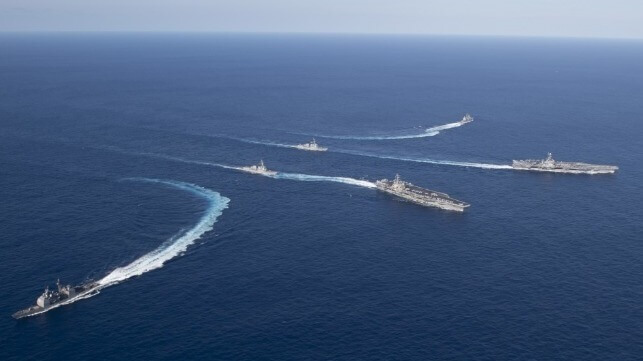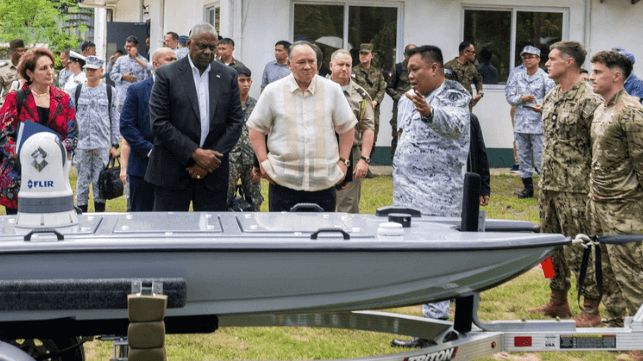
President Joe Biden (C), then-British Prime Minister Rishi Sunak (L) and Australian Prime Minister Anthony Albanese discuss developments in their AUKUS military alliance at Naval Base Point Loma in San Diego, Calif., on March 13. 2023. On Monday, the three countries announced that they have entered an agreement under AUKUS to collaborate on the development of hypersonic weapons. File Photo by Jim Ruymen/UPI | License Photo
Nov. 19 (UPI) -- The United States, Australia and Britain have signed an agreement under their AUKUS defense pact to jointly work on the development of hypersonic technologies.
In a statement on Monday, the three governments said they signed an agreement to enhance testing of hypersonic vehicles and accelerate the implementation of related technologies.
The Hypersonic Flight Test and Experimentation Project Agreement, under Pillar II of their AUKUS pact, specifically states that they may use one another's testing facilities and share technical information concerning the development, testing and evaluating of hypersonic systems.
"We are increasing our collective ability to develop and deliver offensive and defensive hypersonic technologies through a robust series of trilateral tests and experiments that will accelerate the development of hypersonic concepts and critical enabling technologies," Heidi Shyu, under secretary of Defense for Research and Engineering, said in a statement.
The three allies entered into the trilateral AUKUS pact in September 2021 to enable the countries to support one another's security and defense interests, with Pillar I under the partnership being the commitment to aid Australia's acquisition of nuclear-powered submarines.
Pillar II pertains to advanced capability development, including that of hypersonic weapons, which fly at speeds of at least Mach 5, meaning five times the speed of sound, making them difficult to counter.
The United States has been seen as trailing Russia and China in the development of hypersonic weapons, but growing concern about the two countries has spurred both Congress and Pentagon to prioritize building a hypsonic arsenal for the U.S. military.
For example, the Pentagon budget request for hypersonic research in 2025 was $6.9 billion, a jump from $4.7 billion in 2023.
According to Pentagon spokesman Maj. Pete Nguyen, ongoing hypersonic development efforts by the United States, Australia and Britain will be "woven together" through Monday's agree, which includes up to six trilateral flight test campaigns to be conducted by 2028.
Britain's ministry of defense said in a separate statement that this "landmark arrangement" will accelerate their development of hypersonic capabilities, including long-range strike missiles.
"By combining our expertise and resources with those of our closest allies, we are accelerating the development of crucial hypersonic capabilities," Defense Secretary John Healey said.
"This work will keep us ahead of our adversaries on the battlefield, enhance our collective security and contribute to maintaining peace and stability in an increasingly complex and dangerous world."
Indo-Pacific Command's Chief Warns of Hard Limits of Unmanned Systems

In a wide-ranging conversation at the Brookings Institution on Tuesday, Indo-Pacific Command chief Adm. Sam Paparo cautioned against overreliance on unmanned systems in a Taiwan Strait or South China Sea conflict. Though he has spoken extensively on the value of drone systems, he emphasized that it's important not to lose sight of the "laws of physics" of sea power in the vastness of the Pacific Ocean - particularly for sustainment.
"You're going to have to sustain those forces in [Naval Facility Okinawa, Japan] over wide ranging space. You're going to need air and maritime superiority," he said, noting that the Pacific battle space measures about 8,000 miles by 8,000 miles. "I don't think a Victory Garden is going to do it for those folks [in Okinawa] over the course of a war."
The defense community is drawing new lessons from the war in Ukraine, but Paparo emphasized that those lessons only go so far. Ukraine has all of Europe behind it for secure logistics, while Russia has an endless expanse of more Russia. Both are well-defended, and the war is largely restricted to a narrow band of contested space at the front line. This is much different from a Taiwan Strait scenario, he said.
"There's a war of attriction in [Ukraine], and we're learning a lot about electronic warfare, and we're changing the game," said Paparo. "But if you think that's all of it and we can quit on everything else in the Pacific - how are we going to sustain everything else if we completely give up on air and maritime superiority in the Pacific? . . . The PRC has 2,100 fighters. They’ve got three aircraft carriers. They have a battle force of 200 destroyers. 'Oh, well, roger; we’ve got a couple of drones. No problem.'"
He refused to comment on the progress of Project Replicator, a plan to deploy thousands of attritable drones that could be used to defeat Chinese forces in the event of an invasion of Taiwan. But he did insist that such devices must have a "man in the loop" for lethal engagements, and suggested that the concept of an "attritable" device should come with a realistic price tag.
"Attritable systems should [cost] . . . hundreds or thousands of dollars, and reusable systems can end in a different number. We shouldn't confuse that when we're making these choices," he said.
Paparo ended the conversation not on hardware, but on the value of American soft power. He said that he cherishes the strategic advantage that the U.S. military gets when it helps allies with disaster relief and medical assistance. "I value it every bit as much as I do the dynamic demonstration of combat power," he said. "Soft power becomes hard power in conflict."
U.S. Transfers Surveillance Drone Boats to Philippine Military

The U.S. has supplied the Philippine Navy with unmanned drone boats to help with surveillance tasks in the South China Sea, according to the Pentagon.
During outgoing defense secretary Lloyd Austin's fourth and final trip to the Philippines this week, he visited a base on Palawan to meet a forward-deployed U.S. training unit - dubbed Task Force Ayungin, after the Philippine name for a hotly-contested shoal in the Spratly Islands.
Philippine sailors walked Austin through their inventory of American-built Mantas T-12 drone boats. These small high speed surveillance craft measure about 12 feet in length and have a range of about 30-40 miles, making them suitable for short-distance, light-payload applications. Images released by the Department of Defense appear to show a Starlink terminal mounted on a deck hatch, along with a FLIR night vision camera system. The transfer also included at least one Mantas T-38, a larger and more capable speedboat-sized unit.
More USV transfers are expected under a $500 million defense assistance package for Manila. "These developments ensure that the Philippines has the capabilities it needs to defend its rights and its sovereignty throughout its exclusive economic zone," Austin said in a statement.
An enlisted officer with the Task Force told DefenseScoop that there are four T-12s and one T-38 on Palawan, the province nearest the disputed Spratly Archipelago and the home base for Philippine military operations in the region. The next assistance package will include a significant investment in cyber readiness for the Philippine military to ensure that it can maintain command and control of its new unmanned assets, Austin told the outlet.
“We want to make sure that we’re doing everything that we can to help [Philippines Secretary of National Defense Gilbert Teodoro] increase his domain awareness, his ability to protect his sovereign territory and his interests — and cyber plays a critical role in that respect," Austin said.
No comments:
Post a Comment